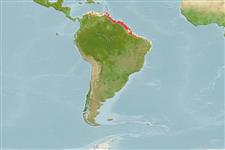Environment: milieu / climate zone / distribuzione batimetrica / distribution range
Ecologia
marino; acqua dolce; salmastro demersale. Tropical; 13°N - 11°S, 77°W - 35°W
Western Atlantic: Caribbean and Atlantic draining rivers and estuaries from Colombia to Brazil.
Length at first maturity / Size / Peso / Age
Maturità: Lm 36.6 range ? - 44.7 cm
Max length : 100.0 cm TL maschio/sesso non determinato; (Ref. 3265); common length : 50.0 cm TL maschio/sesso non determinato; (Ref. 3265); peso massimo pubblicato: 9.0 kg (Ref. 5217); Età massima riportata: 4 anni (Ref. 51629)
Spine dorsali (totale) : 1. The head is more or less flattened, the nostril nearly rounded, mouth inferior. There are three pairs of barbels, 1 pair of maxillary barbel and 2 pairs of mandibular barbels.
Body shape (shape guide): elongated.
Inhabits mainly brackish estuaries and lagoons. Occurs also in freshwaters (Ref. 58022). Found on shallow muddy bottoms (Ref. 5217). Feeds on fish and shrimps. Two annual cycles of slower growth occur during the dry seasons (March and August to November). Life span is three to four years. Sexually mature at 1.5 to 2 years of age. Reproduction takes place from November to April. Consumed as food (Ref. 35381). Marketed fresh. The skull is sold throughout the world as crucifix.
Life cycle and mating behavior
Maturità | Riproduzione | Deposizione | Uova | Fecundity | Larve
Pairing involved in reproduction. Mouth brooding may be employed (Ref. 205).
Taylor, W.R. and N.A. Menezes, 1978. Ariidae. In W. Fischer (ed.) FAO species identification sheets for fishery purposes. West Atlantic (Fishing Area 31). volume 1. [pag. var.]. FAO, Rome. (Ref. 3265)
IUCN Red List Status (Ref. 130435: Version 2025-1)
Threat to humans
Traumatogenic (Ref. 36613)
Human uses
Pesca: commerciale
Strumenti
Special reports
Download XML
Fonti Internet
Estimates based on models
Preferred temperature (Fonte Biblio.
123201): 26.9 - 27.8, mean 27.4 °C (based on 66 cells).
Phylogenetic diversity index (Fonte Biblio.
82804): PD
50 = 0.5078 [Uniqueness, from 0.5 = low to 2.0 = high].
Bayesian length-weight: a=0.00617 (0.00377 - 0.01008), b=3.17 (3.02 - 3.32), in cm total length, based on LWR estimates for this species & (Sub)family-body (Ref.
93245).
Trophic level (Fonte Biblio.
69278): 4.4 ±0.7 se; based on diet studies.
Resilienza (Fonte Biblio.
120179): Alto, tempo minimo di raddoppiamento della popolazione meno di 15 mesi (tm=1.5; tmax=3.5; K=0.5).
Prior r = 0.98, 95% CL = 0.65 - 1.47, Based on 3 data-limited stock assessments.
Fishing Vulnerability (Ref.
59153): High vulnerability (60 of 100).
🛈
Nutrients (Ref.
124155): Calcium = 98.3 [51.2, 205.4] mg/100g; Iron = 1.09 [0.68, 1.92] mg/100g; Protein = 17.3 [15.6, 19.0] %; Omega3 = 0.169 [0.095, 0.304] g/100g; Selenium = 68.5 [33.7, 141.9] μg/100g; VitaminA = 16.1 [6.8, 40.8] μg/100g; Zinc = 0.811 [0.533, 1.257] mg/100g (wet weight);
